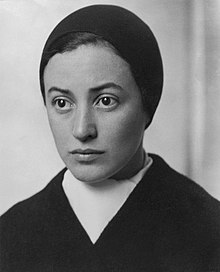Dorothy Norman
Dorothy Norman | |
|---|---|
 Dorothy Norman (Alfred Stieglitz, 1932) | |
| Born | Dorothy Stecker March 28, 1905 Philadelphia, Pennsylvania |
| Died | April 12, 1997 (aged 92) East Hampton, New York |
| Nationality | American |
| Known for | Photography, Writing |
| Spouse |
Edward A. Norman
(m. 1925–1951) |
Dorothy Norman (28 March 1905 – 12 April 1997) was an American photographer, writer, editor, arts patron and advocate for social change.
Biography
Born Dorothy Stecker[1] in Philadelphia to a prominent Jewish family, she was educated in arts and languages from her youth.[2] In 1925 she married Edward A. Norman, the son of an early Sears & Roebuck entrepreneur. They lived in New York City, where Mrs. Norman immersed herself in social-activism groups: as a researcher for the American Civil Liberties Union; with Planned Parenthood, the National Urban League, and the Group Theatre. In the meantime, they had two children together, Andrew and Nancy.
Education
She attended Smith College, then transferred to the University of Pennsylvania, remaining there from 1922 until her 1925 marriage.
Arts patron and Stieglitz devotee
Her life was motivated by "a desire to advance both art and action". She actively cultivated an interest in people who were involved with either the artistic arena or efforts at increasing social equity.[1] In this role she became acquainted with photographer Alfred Stieglitz, who was already a towering influence in the youthful field of art photography when they met in 1927. Although both were married at that time—Stieglitz was married to modern artist Georgia O'Keeffe—Stieglitz became her mentor,[3] her friend, and then her lover. The relationship continued until his death in 1946. Her marriage to Edward Norman ended in divorce in 1951.
Photographer
Norman never worked as a professional photographer, instead capturing images of friends, loved ones and prominent figures in the arts and in politics. People she photographed include Jawaharlal Nehru, Indira Gandhi, Thomas Mann (with his wife Katia, or Katy), John Cage, Marcel Duchamp, Bernard Berenson, Albert Einstein, Theodore Dreiser, Elia Kazan, Lewis Mumford and Sherwood Anderson. She also photographed special sites, special trees, special harbors, special churches and buildings. She detailed the interior of An American Place, Stieglitz's last gallery. She created an extended portrait study of Stieglitz (he returned the favor by creating a similar study of Norman).
Norman's photographic work is noted for its clarity of vision, masterful mix of light and shading, and professional-quality printing techniques.[4]
Norman chose provocative aphorisms by contemporary and historical writers, male and female, and from various cultures, to accompany the thematic groups of photographs in sections of MoMA's world-touring exhibition The Family of Man for its curator Edward Steichen, a long-term associate of Alfred Stieglitz.
Social activism
During the 1930s and 1940s Norman was active in various liberal causes, particularly civil rights, education, and independence for India and she was also a Zionist. She was a founding member of New York City's Liberal Party and a member of the Americans for Democratic Action, and served on the boards of both the New York Urban League and the National Urban League.
Writing career
Norman was a productive author. She wrote a weekly column for the New York Post (1942-1949) and for ten years (1938-1948) edited and published the literary and social activist journal Twice a Year, whose contributors included Richard Wright, Albert Camus, Jean-Paul Sartre and Bertolt Brecht. She wrote or edited numerous books including The Selected Writings of John Marin (1949); Nehru: The First Sixty Years (1965), a two-volume collection of the Indian leader's writings; Alfred Stieglitz: An American Seer (1970), the first full-length biography of the American modernist; and Indira Gandhi: Letters to an American Friend (1985). Her memoir, Encounters, was published in 1987.and also she wrote the book 'The Spirit of India
References
- ^ a b Smith, Roberta. "Dorothy Norman, 92, Dies; Photographer and Advocate". New York Times. Retrieved 21 December 2017.
- ^ She discovered art in her childhood at the Barnes art collection, according to her NY Times obituary
- ^ Norman also had an impressive talent in photography, although her reputation has been buried in her work on Stieglitz' legend (" . . . her enormous, if relatively unknown, talents as a photographer." Brown University)
- ^ http://www.brownedu/Facilities/David_Winton_Bell_Gallery/norman.html[permanent dead link] Notes on the Dorothy Norman Collection at Brown University
